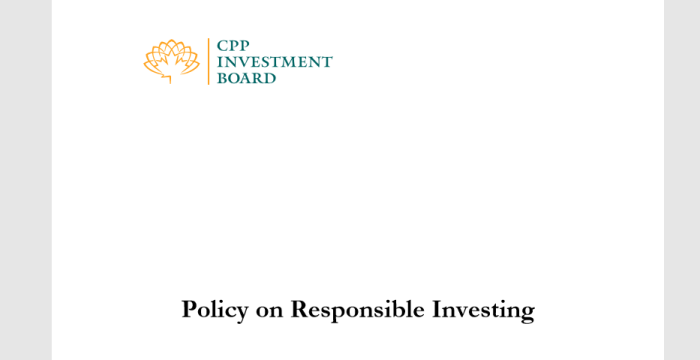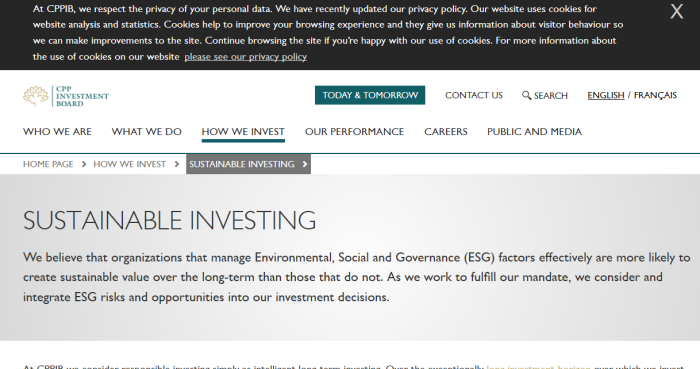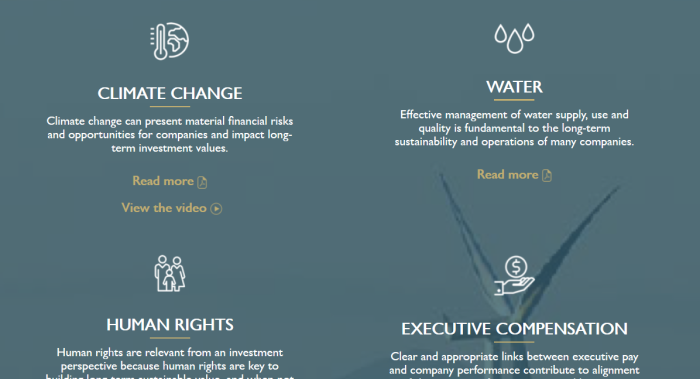


1. More On Pension Plans/Funding
CLICK HERE, for #1: CPPIB invests $2B in Mumbai, India.
CLICK HERE, for #2: CPP underfunded, money leaving Canada.
CLICK HERE, for #3: where is all money actually going?
2. Important Links
(1) https://www.unpri.org/credit-ratings/statement-on-esg-in-credit-ratings/77.article
(2) https://canucklaw.ca/un-principles-for-responsible-investment-esg-agenda/
(3) http://www.cppib.com/en/how-we-invest/sustainable-investing/
(4) http://www.cppib.com/content/dam/cppib/Who%20We%20Are/Governance/Policies/Responsible_Investing_Policy_August2010.pdf
(5) http://www.cppib.com/en/how-we-invest/sustainable-investing/investing-reports/#/engagement
(6) http://www.cppib.com/documents/1902/11396_CPPIB_2018_RSI_Brochure_1_Climate_Change_v1c.pdf
(7) http://www.cppib.com/documents/1904/11396_CPPIB_2018_RSI_Brochure_3_Human_Rights_v1b.pdf
(8) https://canucklaw.ca/international-economic-forum-of-the-americas-and-a-100t-salespitch/
(9) http://www.cppib.com/documents/1922/CPPIB_SI_2018_ENG.pdf
For some context on the American situation:
CLICK HERE, for Social Security unable to pay obligations by 2034.
3. Quotes From 2010 Policy Guide
We are guided by certain principles as they relate to responsible investing. These include, but are not limited to, the following:
• The overriding duty of the CPP Investment Board, consistent with its mandate, is to maximize investment returns without undue risk of loss;
• Portfolio diversification is an effective way to maximize long-term riskadjusted returns;
• Portfolio constraints either increase risk or reduce returns over time;
• Responsible corporate behaviour with respect to environmental, social and governance (ESG) factors can generally have a positive influence on longterm financial performance, recognizing that the importance of ESG factors varies across industries, geography and time;
• Disclosure is the key that allows investors to better understand, evaluate and assess potential risk and return, including the potential impact of ESG factors on a company’s performance;
• Investment analysis should incorporate ESG factors to the extent that they affect risk and return;
CLICK HERE, for CPPIB expecting to invest more than just 8% in China.
3.0 Investment Strategy In the context of our long-term investment horizon, the CPP Investment Board aspires to integrate ESG factors into investment management processes, where relevant, for all asset classes within the portfolio. As stated in our principles above, it is our belief that responsible corporate behaviour with respect to ESG factors can generally have a positive influence on long-term financial performance.
For public equities, the CPP Investment Board’s responsible investing team works with internal portfolio managers to assess ESG risks and opportunities as they relate to overall corporate performance. In our private market and real estate investments, ESG factors are evaluated, where applicable, in the due diligence process and monitored over the life of the investments
4.4 Industry Dialogue The CPP Investment Board participates in broader domestic and international discussion about definitions, priorities, standards and best practices in responsible investing.
.
The CPP Investment Board participates in a number of organizations, including:
.
• UN Principles of Responsible Investment
• Canadian Coalition for Good Governance
• Pension Investment Association of Canada
• International Corporate Governance Network
• Council of Institutional Investors
First things first. This policy guide was released in August 2010 when Stephen Harper was Prime Minister, not Justin Trudeau.
The guide outlines repeatedly how UN principles for responsible investment (PRI) will be followed. It also states that environmental, social, governance factors (ESG) will also be taken into account. This is right out of the UN agenda.
4. CPPIB’s So-Called “Focus Areas”

- Climate Change
- Water
- Human Rights
- Executive Compensation
- Board Compensation
Shouldn’t a pension fun be focused on growing the size of the fund first and foremost? Why does virtue signalling have to factor into absolutely everything? But this isn’t the worst of it. Let’s dig a little deeper into these categories.
5. CPPIB Starts Issuing “Climate Bonds”

In June 2018, CPPIB completed its inaugural issuance of green bonds, becoming the first pension fund in the world to do so. Investors bought $1.5 billion of the 10-year bond, which Bloomberg reported was a record at the time for a single green bond transaction in Canada.
Since their introduction in 2007, green bonds have become a mainstream way for companies, governments and other organizations to raise funds for projects with environmental benefits. The issuance of a green bond was a logical next step to our investment-focused approach to climate change. Capital was raised to provide additional funding as we pursue acquisitions of strong, long-term investments eligible under our Green Bond Framework. In the 12 months to June 30, 2018, we announced plans to invest more than $3 billion in renewable energy assets.
This sounds lovely, except the CPPIB seems oblivious to the complete money pit that “green initiatives” have shown to be in projects across Canada and elsewhere. I really don’t see how they will be able to repay investors for these bonds.
Climate change is one of the most significant physical, social, technological and economic challenges of our time. Its impacts are expected to be pervasive and broad-ranging. Scientists believe it is critical to limit global warming to less than two degrees Celsius (2°C) above pre-industrial levels in order to prevent irreversible damage. Rising temperatures and sea levels create physical and transition risks, such as water scarcity, threats to biodiversity, extreme weather and policy and market risks.
Such changes also create potential investment opportunities in areas such as technological innovation and renewable energy (see table on page 2 for details) that may present themselves in the near, medium or long term. Given our exceptionally long investment horizon, we are actively addressing climate change to increase and preserve economic value, in accordance with our mandate. The implications of the global transition to lower carbon sources of energy will be far reaching for investors and companies alike.
It is difficult to tell what (if any) the board actually believes in this climate change, and how much is simply a shrewd business move. See here, for more info on climate bonds.
It appears that CPPIB is simply trying to profit from the political winds that is the climate change agenda. And it is using Canadian pension funds to finance this openly partisan agenda.
6. Human Rights As Business Perspective
Why We Engage
Human rights are relevant from an investment perspective because operational disruptions and reputational damage can arise when these matters are not appropriately managed. Effective human rights management is important for companies’ enhancement of long-term value.
We believe strong human rights practices contribute to sustaining long-term value. Working with companies in our portfolio on this topic is an important part of our mandate to maximize long-term returns. Companies with strong human rights policies and practices are less likely to face disruptions to operations from legal and regulatory risk, protests, workforce action and other activities. They are also less likely to suffer reputational damage due to human rights-related controversies. We also assess human rights risks within the supply chain of companies, primarily considering poor working conditions and labour issues (such as child labour). We are currently focusing our efforts on supply chain management in the consumer and information technology sectors.
So much for principles here. Human rights not from a moral or ideological perspective, but purely from a commercial one.
7. Sustainable Financing Report For 2018
Note: the report indicates that only 15% of the various investments are actually within Canada. The rest are abroad, including 38% in the US.
Also worth noting: the CPPIB claims to have $356.1 billion in assets. The reality (using close-group valuation actually rates it at almost $1 trillion in liabilities all told.
We integrate environmental, social and governance factors into our investment analysis, both before and after making investments. Our Sustainable Investing group works with investment teams throughout CPPIB to help them identify and assess ESG matters.
CPPIB’s assessment of ESG considerations can be an important factor in determining whether a potential investment is attractive. Where such ESG considerations are material, they can significantly affect our assessment of a company’s risk profile and value.
CPPIB’s Sustainable Investing group works across the organization to support investment analyses on the impact of ESG factors. It also conducts research on industry standards and best practices, and expands our knowledge and resources by collaborating with external partners and industry associations.
Subsequent pages go on at length about the ESG (environment, social, government) goals. However, the point is pretty clear. All investment decisions, including areas to invest in, are looked at through this lens.
8. Why Involve Our Pensions In This?
This reeks of social engineering more than any real sound financial advice. The CPPIB seems to drink the climate change Kool-Aid in its entirety with this.
While diversifying a portfolio makes sense, it is rather troubling that the overwhelming majority (85%) of the fund is actually being sent overseas. Wouldn’t it make more sense to be investing in Canadian projects and infrastructure?
Once the money leaves Canada, it becomes difficult, if not impossible to track and keep control of.
